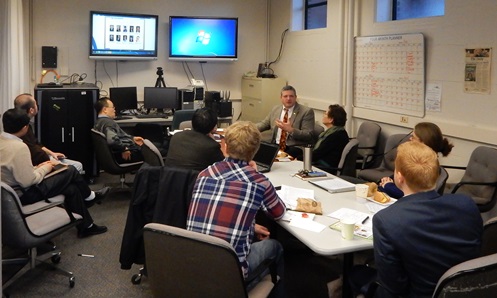-
March 06, 2015
PacTrans, WTSC Meet for Safety Workshop
PacTrans and the Washington Traffic Safety Commission (WTSC) met on March 3 at the University of Washington to exchange information and learn more about the activities of each organization for potential collaboration. With transportation safety a primary goal, WTSC and PacTrans are strategically aligned and find partnerships with other agencies and organizations critical to developing safe solutions.
Darrin Grondel, Director of WTSC, provided a background of the commission and discussed top programs and priorities. Guiding the commission’s priorities is Washington’ Strategic Highway Safety Plan, called Target Zero, which aims for zero deaths and serious injuries on roadways by 2030. The plan is formed through a collaboration of traffic safety professionals and organizations from a variety of disciplines, and preliminary conversation indicates a future contributing role for PacTrans.
The workshop also provided a venue for PacTrans researchers to present their work in a wide range of safety-related topics. Dr. Anne Vernez-Moudon, Urban Design and Planning professor and PacTrans Associate Director of Education, presented her talk, “High-risk Locations of Pedestrian –motor-vehicle Collisions in King County: A Data-Driven Approach.” Her question to the group: what kind of cities do we make to support non-motorized, active transportation?
Dr. Yinhai Wang, Civil and Environmental Engineering professor and director of PacTrans, gave an overview of transportation safety research at the PacTrans STAR Lab. Topics covered included the method for traffic safety data collection and quality control, mechanism-based accident models that include human factors in the analysis, and large scale highway safety analysis through DRIVE Net, the Digital Roadway Interactive Visualization and Evaluation Network.
Dr. Qing Shen, Urban Design and Planning professor, discussed graduate student Peng Chen’s research on the risks of bicycle use in the urban environment. The study of bicycle routes, injuries, and bicycle-vehicle crash frequency lead to a discussion of preliminary policy implications, including the separation of bike lanes from roads and the avoidance of placing bike lanes on steep roads.
Kris Henrickson, Civil and Environmental Engineering PhD student, discussed mobile MAC addressing and mobile platforms for crowdsourcing transportation safety data. Henrickson explained that collecting non-motorized transportation safety data is challenging, but ubiquitous mobile computing has made crowdsourcing possible and even affordable.
Dr. Jessica Kaminsky, Civil and Environmental Engineering assistant professor, presented her talk, “Work Zone Safety and Social Network Analysis.” Stressing the importance of construction safety research, Dr. Kaminsky stated that construction-related work accounts for 16% of all occupational fatalities, and finds that safety communication is a cost effective way to decrease incidents on construction sites.
This information sharing workshop generated a great deal of interest in further partnerships. Collaborative ideas were raised and discussed through a follow up lunch meeting. WTSC will participate in the PacTrans regional transportation safety workshop to be held in early May and bring in their top research issues with other local transportation agencies. PacTrans looks forward to working with these local transportation agencies to identify critical regional transportation safety problems and develop the corresponding research agenda for the years to come.



